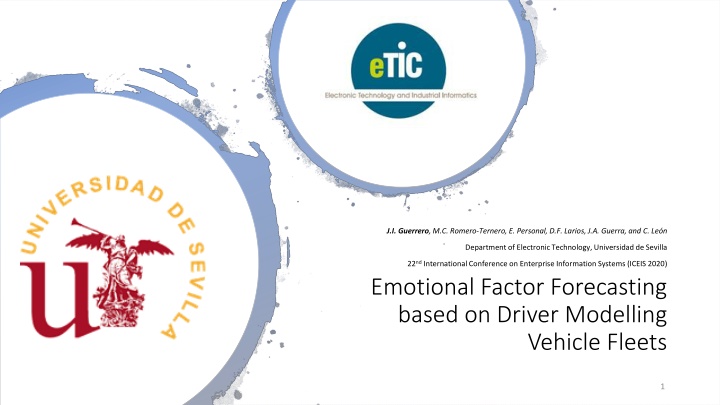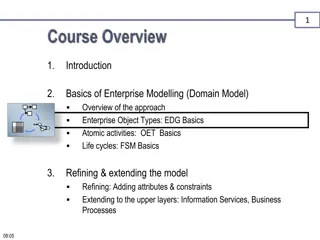
Emotional Factor Forecasting in Electric Vehicle Fleet Management
Explore how driver behavior affects the energy consumption of electric vehicles through emotional factor forecasting based on driver modeling. The research delves into key aspects such as information acquisition, route scheduling, and the impact of driver patterns on state of charge calculations. Various algorithms are employed for efficient fleet management and optimization in this innovative approach.
Download Presentation

Please find below an Image/Link to download the presentation.
The content on the website is provided AS IS for your information and personal use only. It may not be sold, licensed, or shared on other websites without obtaining consent from the author. If you encounter any issues during the download, it is possible that the publisher has removed the file from their server.
You are allowed to download the files provided on this website for personal or commercial use, subject to the condition that they are used lawfully. All files are the property of their respective owners.
The content on the website is provided AS IS for your information and personal use only. It may not be sold, licensed, or shared on other websites without obtaining consent from the author.
E N D
Presentation Transcript
J.I. Guerrero, M.C. Romero-Ternero, E. Personal, D.F. Larios, J.A. Guerra, and C. Len Department of Electronic Technology, Universidad de Sevilla 22ndInternational Conference on Enterprise Information Systems (ICEIS 2020) Emotional Factor Forecasting based on Driver Modelling Vehicle Fleets 1
Contents Architecture View The Electric Vehicle Fleet Management VPP Information Acquisition from Electric Vehicle Driver Patterns Real-Time Route Scheduling SoC Module Data mining algorithms Sample description Experiment results Conclusions 2
Architecture View VPPs: Energy VPP Distribution VPP Retailer VPP Smart Business VPP Algorihtms: Genetic Algorithm (GA) Genetic Algorithm with Control Evolution (GAEC) Particle Swarm Optimization (PSO) Hybrid approach 3
The EV Fleet Management VPP Electric Vehicle Fleet Management VPP or Node (EVFMN) Some modules, such as external coordination and prioritization algorithm are available for all VPPs. The other modules depend on the available information in the VPPs. For example, the SBVPP has all information about the EV fleet; however, the SBVPP may have additional services of energy efficiency if it shares the information with the RVPP (in this case, the RVPP would use the energy efficiency module). In case of Driver Modelling, it is not included in the EVPP level, and it optionally could be included in RVPP, depending on the services provided by this level. 4
Information Acquisition from EV Intermediate systems to gather the information (Rasberry, Jetson, etc.) Standarized CAN-bus protocol ODB-II to Bluetooth interface --> mobile application Currently, the information is gathered at the end of full working day. 5
Driver Pattern Driver behaviour is stored in driver patterns. The driver pattern is a model that takes effect over the consumption of a vehicle in route scheduling. The driver pattern affects the calculated SoC for each section of a route; it depends on the terrain topology and traffic data. Driver behaviour is calculated according to the historical data of a driver. If historical information about a driver is not available, this pattern will be calculated only with the emotional information. The driver pattern consists of the deviation from the original predicted SoC. A default average driver pattern can be created when a system has adequate information. The Driver Modelling process is based on Generic Rule Induction (GRI), Support Vector Machine (SVM) and K-Means clustering algorithm involving the Cronbach alpha variation analysis, which uses the information provided by acquisition system: accelerator and brake usage, average speed, variation of revolution per minute (rpm), usage of HVAC in the vehicle, brake energy restoration, etc. All this information provides a classification of driver pattern, which is translated into a set of typical values for different parameters in a different confidence ranges and correlation variation. 6
Real-Time Route Scheduling This module controls several conditions that can modify the current prioritization charging queues. This module notifies any change in the following conditions: Driver and EV availability. Route modifications. Traffic and roadwork. Weather conditions. Charging station availability 7
SoC Module The proposed solution is based on the instantaneous SoC value of each EV. These algorithms require an estimation of some consumption according to its planned route and alternative routes to reach different recharging spots. This consumption estimation is supported by a route planning tool 8
Data Mining Algorithms This technique aids to classify the different parameters according to their variance related to other parameters, providing a map of the importance of different parameters in the driver pattern. The Cronbach alpha calculated for all parameters provided a general number, which describe the correlative variance between parameters. Additionally, the Cronbach alpha relative to each parameter p is calculated, providing a new value for Cronbach alpha corresponding to the new correlative variance, without the influence of the corresponding parameter p. GRI Cronbach and SVM 9
Data Mining Algorithms Classifies the values according to the Cronbach Alpha stablishing classifications for each range of each parameter. Additionally, the algorithm is used to classify the different results of patterns, making groups according to the common characteristics of the driver behaviour. The method supposed that the driver drives with a pattern and this pattern is related to emotional context. Thus, the different groups describe different emotional status. In this case, it is not important to reveal the emotion. GRI Cronbach K-means and SVM 10
Experimental Results GRI Cronbach K-means and SVM 11
Conclusions The proposed platform can integrate information from electric vehicles to be considered as part of the electric vehicle fleet management platform for the integration of its in smart grids as mobile loads. The role of emotion in automotive driving is increasingly present, empowering human- centred design coupled with affective computing in driving context to improve future automotive design. The driver emotional status influence is modelling by the deviation of the driver pattern based on a Generic Rule Induction, Support Vector Machine and K- Means clustering algorithm involving the Cronbach alpha variation analysis, which provides a light-weight model to perform in low feature devices. On the other hand, electric vehicle fleets and smart grids are technologies that have provided new possibilities to reduce pollution and increase energy efficiency looking for sustainability. The inclusion of driving data can improve the routing and charging prioritization forecasting, providing additional services to the different actors in the energy market, and other advantages for the better stability of the power grid. 12
Future Works The future works will be centred on provide more information about driver, including some devices to provide more information about emotional status of driver, based on biometric factors or emotional estimation by means of face image analysis. This information provides more possibilities to analyse the results presented in the present paper. 13
Questions Thank you 14






















